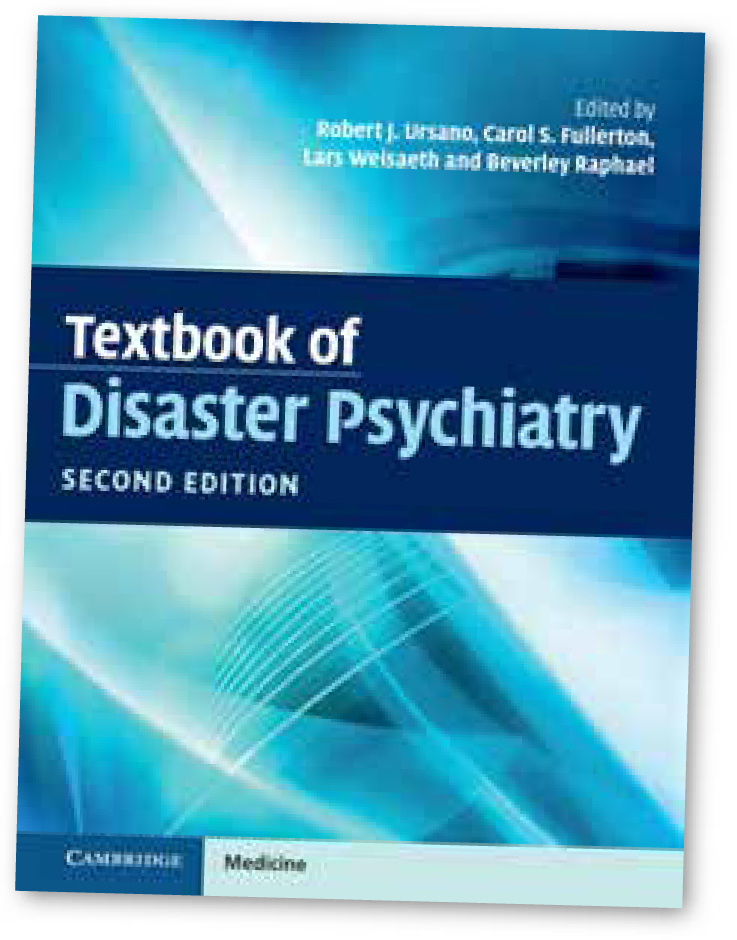
It is well documented that there has been a year-on-year increase in both man-made and natural disasters. According to Guha-Sapir et al (2014), globally there is an average frequency of more than one disaster per day. Coupled with an ever-growing world population, this results in more people being affected by such events.
The effects of these events can be far-reaching and touch every aspect of life, but the way in which they are managed plays a significant role on long-term impacts and the speed of recovery back to a functioning society.
This book explores many aspects of disaster psychiatry in a readable format and consistently supported by a large bank of evidence. This hardback textbook comes with a fairly hefty price tag, at £84.99 from the publisher; however within the first few pages, you are presented with a list of 79 contributors. The list of professionals from across the globe also comes with an array of impressive post-nominal letters—with the prize going to Richard William with no less than ten. This is representative of the quality of text which follows; it is 350 pages of well-written, well-referenced, and easily readable information which packs an academic punch. This more than justifies its price tag.
This is the second edition and boasts cutting-edge scientific information. The book covers subjects ranging from epidemiology of disaster response, ecology to neurology, early interventions to consultation liaison care for the disaster victim—among many other aspects of disaster psychiatry. The book is divided into five parts and each is broken down into chapters. Despite the number of contributors, it doesn't feel disjointed in its style. Much of the text is supported by a variety of simple graphs, charts and models, which serve to break the text up and assist understanding of some of the more complex aspects. The supporting graphics appear fairly infrequently so you can often be presented with page after page of text. Despite this, it really is quite easy to read and you don't find yourself bogged down with science. The text is constantly linked to major world disasters which delivers context to the arguments posed.
The reader is drawn in from the first chapter. There is a swift delivery of fascinating facts, numbers and figures from across all continents, including natural and man-made disasters, terrorism, and pandemics. Nothing is missed and all backed by academic references. I was quite shocked to hear that there are 23 ongoing wars across the world; however, I was even more surprised that this was referenced to Wikipedia. Having said that, this was the only time I spotted this reference.
While analysing the way in which disasters have affected various populations, useful links are made to most of the major disasters that have occurred across the world. There is deep exploration of how to mitigate the risks which will inevitably present following such events. It's no surprise that access to social support and efficient leadership are seen in a positive light.
Social media is brought into the picture when talking about disaster management. There is a strong bank of evidence provided around the impact of this growing industry and its effects when disaster strikes. The younger generation is pointed out to be at most risk of re-traumatisation. Even the introduction of high definition (HD) television is alleged to exacerbate the problem. All these claims are evidenced although this is only up to 2014. Four years is a long time in relation to social media growth, which suggests that today, the effects may be more intense.
Once I had read the book and made a mountain of notes, there was one chapter I found myself drawn back to—this was Chapter 4 on neurobiology. I found this the most relevant to paramedic practice: much of the focus is on post-traumatic stress disorder (PTSD), looking at how it is diagnosed and the science behind the condition.
Also highlighted is the importance of psychological first aid which should focus on education and screening. For example, trauma risk management (TRIM) is now successfully implemented in a number of ambulance services across the country. This screening is suggested as a positive tool rather than a needless intervention. Explanation is given on how CT and PET scans show the changes that occur during the ‘fight or flight’ phase and PTSD. This provides some reassurance that these conditions have a physical manifestation which can help improve attitudes towards mental health.
I still find that, certainly when talking to students and new members of staff, there is almost an expectation that at some point in their career, they will suffer from PTSD. This simply is not true; in fact, the text explores post-traumatic growth (PTG) which essentially is a building of resilience following repeated exposure to potentially difficult situations. This is far more likely to occur to frontline staff and is a positive experience.
This book should feature in the library of every ambulance service resilience department and should not gather dust. The long-term mental health impact of disaster is clearly demonstrated and well evidenced throughout this book. Unfortunately, I suspect supporting the mental health of communities affected by disaster will mirror current practice—meaning it will not always be the highest priority. Alternatively, if you have an interest in health and wellbeing, there are many parallels that can be drawn and useful points to take from this excellent book.

